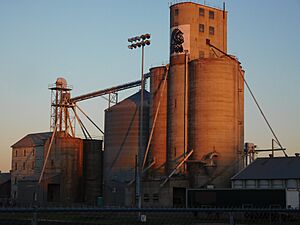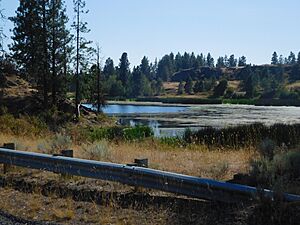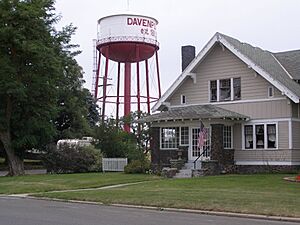Davenport, Washington facts for kids
Quick facts for kids
Davenport, Washington
|
|
|---|---|
| City of Davenport | |
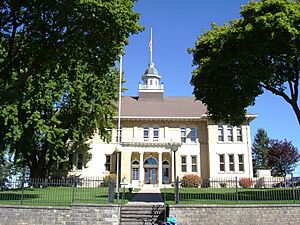
Lincoln County Courthouse
|
|
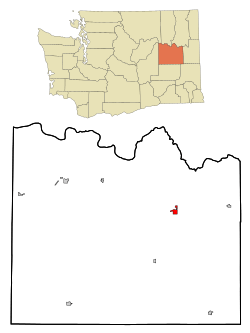
Location of Davenport, Washington
|
|
| Country | United States |
| State | Washington |
| County | Lincoln |
| Area | |
| • Total | 1.67 sq mi (4.32 km2) |
| • Land | 1.67 sq mi (4.32 km2) |
| • Water | 0.00 sq mi (0.00 km2) |
| Elevation | 2,375 ft (724 m) |
| Population
(2020)
|
|
| • Total | 1,703 |
| • Density | 1,019.7/sq mi (394.2/km2) |
| Time zone | UTC−8 (Pacific (PST)) |
| • Summer (DST) | UTC−7 (PDT) |
| ZIP code |
99122
|
| Area code(s) | 509 |
| FIPS code | 53-16795 |
| GNIS feature ID | 1504329 |
Davenport is a city in Washington state, USA. It is the main city and county seat of Lincoln County. In 2020, about 1,703 people lived there. Davenport is an important place for businesses, healthcare, and schools in Lincoln County.
Contents
History of Davenport
Before European settlers arrived, the land around Davenport was home to the Lower Band of the Spokane tribe. This area was also a popular trade route from east to west. A natural spring in what is now Davenport was a great spot for travelers to rest and get water.
White settlers later used this same trail. Gold prospectors passed through on their way to goldfields in Montana. Like the Spokane people, these new arrivals used the springs to get water and camp. Because of these springs in a dry area, some settlers decided to stay. In 1880, Aloysius Harry Harker became the first non-native person to settle there permanently. John and Emma Eads Nicholls arrived soon after. This settlement was called Cottonwood Springs.
In 1883, John C. Davenport started another settlement nearby on higher ground. A fire destroyed it the next year. Davenport's settlement then moved to Cottonwood Springs, and the town took his name. On December 15, 1896, Davenport became the county seat of Lincoln County. This happened after an election where Davenport won against Sprague (which had been damaged by fire) and Harrington.
Davenport grew quickly when the Northern Pacific Railway (NP) railroad arrived in February 1889. The Seattle, Lake Shore and Eastern Railway (SLS&E) came later that year. Another train line, the Great Northern Railway (GN), was built to Davenport in the 1920s. Davenport's train station, built in 1889, was used for almost 100 years before it was taken down in 1988.
Major highways also came through Davenport. U.S. Route 2 (once called "Sunset Highway") now runs through the city. Washington State Route 28 also starts in Davenport, connecting it to rural areas. Washington State Route 25 begins in Davenport and goes north to the Canadian border.
Geography of Davenport
Davenport is mostly flat, located in a shallow valley. However, the area around it has unique landforms called the Channeled Scablands. These were carved out by huge floods during the last ice age. Davenport is on the northern edge of these scablands. Cottonwood Creek, which flows into the Columbia River, is fed by Crystal Spring, located near the center of town.
U.S. Route 2 goes right through Davenport. This highway connects Davenport to Spokane, which is about 35 miles (56 km) to the east. Two state highways also serve Davenport: State Route 28 and State Route 25.
Davenport is in the middle of a big wheat-growing area. Dryland wheat farming is very important to the local economy. Large grain elevators in Davenport collect wheat from the farms. Most of this wheat is shipped out by truck or train. Some wheat goes to flour mills in Spokane and Cheney. Local barley is also sent to breweries and other users.
The city covers about 1.67 square miles (4.32 square kilometers) of land.
Climate
Davenport has a dry-summer continental climate. This means it has warm, dry summers and cold winters.
| Climate data for Davenport, Washington (1991–2020 normals, extremes 1893–1894, 1909–present) | |||||||||||||
|---|---|---|---|---|---|---|---|---|---|---|---|---|---|
| Month | Jan | Feb | Mar | Apr | May | Jun | Jul | Aug | Sep | Oct | Nov | Dec | Year |
| Record high °F (°C) | 58 (14) |
60 (16) |
73 (23) |
90 (32) |
94 (34) |
107 (42) |
105 (41) |
103 (39) |
100 (38) |
86 (30) |
68 (20) |
57 (14) |
107 (42) |
| Mean daily maximum °F (°C) | 31.7 (−0.2) |
37.1 (2.8) |
46.7 (8.2) |
55.9 (13.3) |
65.4 (18.6) |
72.1 (22.3) |
82.3 (27.9) |
82.5 (28.1) |
72.6 (22.6) |
57.1 (13.9) |
41.5 (5.3) |
31.2 (−0.4) |
56.3 (13.5) |
| Daily mean °F (°C) | 25.5 (−3.6) |
29.1 (−1.6) |
36.8 (2.7) |
43.6 (6.4) |
52.0 (11.1) |
57.7 (14.3) |
65.1 (18.4) |
65.1 (18.4) |
56.5 (13.6) |
44.0 (6.7) |
33.2 (0.7) |
25.2 (−3.8) |
44.5 (6.9) |
| Mean daily minimum °F (°C) | 19.3 (−7.1) |
21.2 (−6.0) |
26.9 (−2.8) |
31.2 (−0.4) |
38.5 (3.6) |
43.4 (6.3) |
47.9 (8.8) |
47.7 (8.7) |
40.3 (4.6) |
30.9 (−0.6) |
25.0 (−3.9) |
19.2 (−7.1) |
32.6 (0.3) |
| Record low °F (°C) | −28 (−33) |
−27 (−33) |
−9 (−23) |
10 (−12) |
16 (−9) |
25 (−4) |
29 (−2) |
29 (−2) |
17 (−8) |
−1 (−18) |
−18 (−28) |
−23 (−31) |
−28 (−33) |
| Average precipitation inches (mm) | 1.73 (44) |
0.99 (25) |
1.53 (39) |
1.11 (28) |
1.37 (35) |
1.15 (29) |
0.42 (11) |
0.30 (7.6) |
0.49 (12) |
1.26 (32) |
1.72 (44) |
1.90 (48) |
13.97 (355) |
| Average snowfall inches (cm) | 7.4 (19) |
5.5 (14) |
2.2 (5.6) |
0.2 (0.51) |
0.0 (0.0) |
0.0 (0.0) |
0.0 (0.0) |
0.0 (0.0) |
0.0 (0.0) |
0.3 (0.76) |
4.1 (10) |
10.6 (27) |
30.3 (77) |
| Average precipitation days (≥ 0.01 in) | 8.2 | 6.2 | 8.3 | 6.2 | 6.6 | 6.2 | 2.6 | 2.1 | 3.2 | 6.0 | 9.2 | 9.1 | 73.9 |
| Average snowy days (≥ 0.1 in) | 4.6 | 2.7 | 1.4 | 0.1 | 0.0 | 0.0 | 0.0 | 0.0 | 0.0 | 0.1 | 2.4 | 5.5 | 16.8 |
| Source: NOAA | |||||||||||||
People in Davenport
| Historical population | |||
|---|---|---|---|
| Census | Pop. | %± | |
| 1890 | 396 | — | |
| 1900 | 1,000 | 152.5% | |
| 1910 | 1,229 | 22.9% | |
| 1920 | 1,112 | −9.5% | |
| 1930 | 987 | −11.2% | |
| 1940 | 1,337 | 35.5% | |
| 1950 | 1,417 | 6.0% | |
| 1960 | 1,494 | 5.4% | |
| 1970 | 1,363 | −8.8% | |
| 1980 | 1,559 | 14.4% | |
| 1990 | 1,502 | −3.7% | |
| 2000 | 1,730 | 15.2% | |
| 2010 | 1,734 | 0.2% | |
| 2020 | 1,703 | −1.8% | |
| U.S. Decennial Census 2020 |
|||
Davenport's Population in 2010
In 2010, there were 1,734 people living in Davenport. There were 694 households and 445 families. The city had about 952.7 people per square mile.
Most people (95.3%) were White. About 1.2% were Native American. People of Hispanic or Latino background made up 2.7% of the population.
About 31.1% of households had children under 18 living with them. The average household had 2.43 people, and the average family had 3.03 people.
The average age in the city was 40 years old. About 25.5% of residents were under 18. About 19% were 65 years old or older. Slightly more than half (52.4%) of the population was female.
Community Life in Davenport
The Davenport School District serves the community. It includes Davenport Elementary, Davenport Middle School, and Davenport Senior High School. Their school mascot is the Davenport Gorilla!
In 2010, Davenport had 12 different churches. It also had a museum, a library, and a city park with a swimming pool. Important services in the community include a post office, a courthouse, a fire station, and a hospital. The Lincoln County Fairgrounds are in Davenport, where the annual Lincoln County Fair and Rodeo takes place every summer.
Transportation in Davenport
Davenport has several ways to get around:
- Davenport Municipal Airport
- Eastern Washington Gateway Railroad
- U.S. Route 2
- State Route 28
- State Route 25
See also
 In Spanish: Davenport (Washington) para niños
In Spanish: Davenport (Washington) para niños


